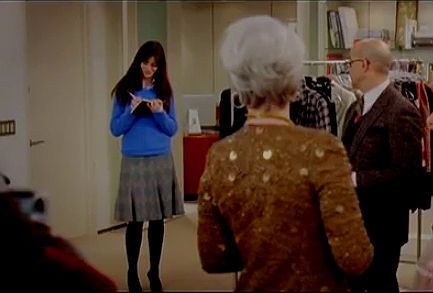 |
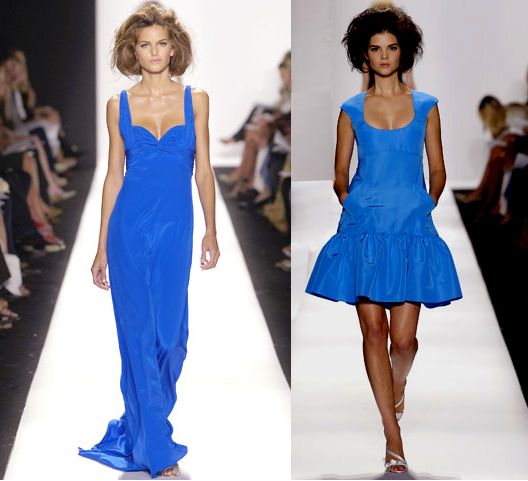 |
Spring, 2007 Ready To Wear Cirulean Dresses
In the back-and-forth world of movies and fashion, it could be that Miranda Priestly's reference to an Oscar de la Renta cirulean gown in The Devil Wears Prada (which did not exist when the movie came out in 2006), could have influenced the designer to produce the cirulean gowns above!
Miranda Priestly, to Andy Sachs:
And you're also blithely unaware of the fact that in 2002, Oscar de la Renta did a collection of cerulean gowns?
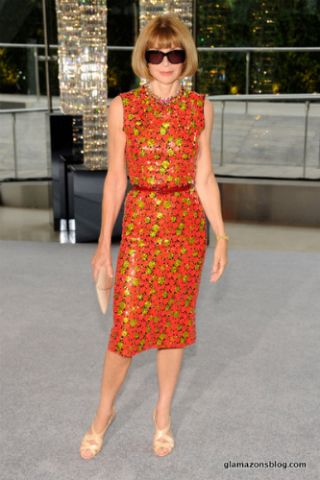 |
in Marc Jacobs, in 2012.
For her, attractive, colorful clothes.
For Vogue, post-modern black and twisted shapes.
-----------------------------------------------------------------------------------------------------------------------------------
Sometimes a silly film inadvertently tells us some truth. But, I don't really think it is inadvertent as much as how much of the truth can deliberate truth-destroyers destroy. At some point, things clear up and the unadulturated truth pops up.
Such is the case in the pleasant movie The Devil Wears Prada, where a jobless recent graduate of journalism school finally gets an interview with Runway, a fashion magazine.
I wonder why its producers, directors, financiers, film critics, who are 99% liberal and anti-beauty and hence anti-fashion, showed the film in such a warm light? The film is pleasant to watch, and doesn't have any of the bitterness of beauty-haters.
Well, Andy does make it into "real" journalism at the end of the film, securing a position at some New York Post type of newspaper, where she will be writing about social inequalities and other "issues." But she gets to keep her Gucci too. That's the trick: she gets it all! Which is what modern media wants young women to believe: wear your Diors and get that socially responsible degree. She should look pretty while saving the world. If the message is too hard-core, young, socially responsible women, who still want to look pretty if not beautiful, would be running as far away as possible from social consciousness.
But is Andy's "social issues" type of journalism really challenging? Does she really save the world with it? Is she willing to relocate to Somalia for several months to report on the social inequalities there? Or will she simply maneuver her position to stay in beautiful New York, live in a smart downtown apartment, and travel occasionally to Harlem on the A train (the subway line romanticized by Duke Ellington's song) in a more modest Gucci, to write about social inequalities there? And while in Harlem, why not try one of those (safely located) soul food restaurants that are sprouting up all over Harlem for the likes of her: socially conscious whites looking for "safe" places to eat in Harlem?
Take the A Train
(Music by Billy Strayhorn.
With singer Joya Sherrill, who is credited for the lyrics
(she starts singing around the 1:10 point)
Take the A Train
You must take the A train
To go sugar hill 'way up in Harlem
If you miss the A train
You'll find you've missed the quickest way to Harlem
Hurry, get on now it's coming
Listen to those rails a thrumming
All 'board get on the A train
Soon you will be on sugar hill in Harlem
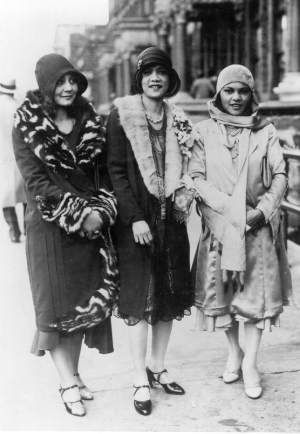 |
Women in Sugar Hill, Harlem, ca. 1920
Attributed to James Van Der Zee
Why, New York is the solution. She can have her cake and her soul food - a chef-baked cake from that quaint store in SoHo, and the soulful catfish from the Harlem kitchen - and compose her heart-felt social inequality columns on her laptop, sitting at the desk she recently bought from that antique store in Chelsea.
 |
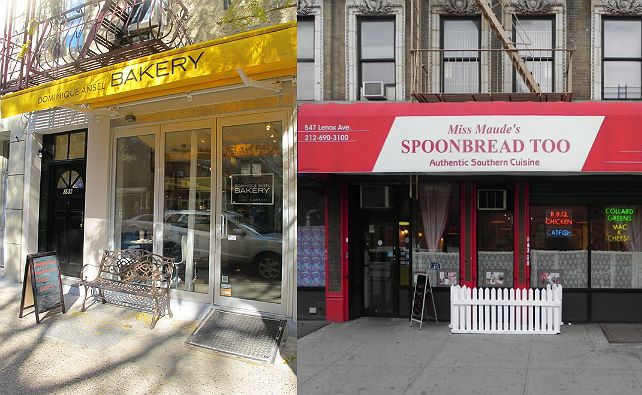 |
But these clever social engineers know that practical lumpy sweaters will start to take over. Who has time to look like a Vogue model, and write that article by a deadline? Other biological determinants will also start to dictate, like young women wanting to be kind and nice unlike that horrifically callous male boss who sees projects as objects and not as people. So try as they might, these social engineers cannot change the essence of girls, and women, so they have to sugar coat their goals in softer language.
Miranda Priestly, the editor-in-chief of Runway, is supposed to be a take on Vogue editor-in-chief Anna Wintour. But Priestly is concerned only with the aesthetics of her magazine, whereas Wintour is a social engineer par excellence, where she interlaces the big and heavy Vogue (the October 2013 issue has 380 pages, September's - which I discuss here - 902 pages) with causes and "issues" mostly featuring women (and if men are featured, their wives take up much of the article, as in the article on Rand Paul in the October 2013 issue, where a profile of his wife takes up a chunk of the issue.
In the September 2013 issue there is a profile of Susan Rice titled The Comeback Queen (pp 506-510):
She makes her entrance wearing a scoop-neck blouse, black trousers, and a striking green Ultrasuede jacket accented with circles cut above the hem that she bought at a Smithsonian Craft Show. Her hair is combed back to her shoulders, and a gold watch and bracelet flash on her wrists. She introduces [New York Times's executive editor Jill] Abramson to Gerard Araud, the French ambassador to the U.N., embraces [Mia] Farrow, then spots David Dinkins, the venerable former mayor of New York. She hands him her own champagne flute, says "Cheers," and fist-bumps the glass.In the October 2013 isse, there is an article on Cori Bergman, who
...has quietly become one of the country's most respected neuroscientists. Now she's leading President Obama's $100 million effort to solve the mysteries of the human brain. [Vogue, September 2013, p179-186]Even the advertisements have a political angle. A Bulgari advertisement takes up two pages, featuring a necklace of emerald and ruby cabochons on the bare torso of Mrs. Nicolas Sarkozy, who has clearly returned to her modeling roots.
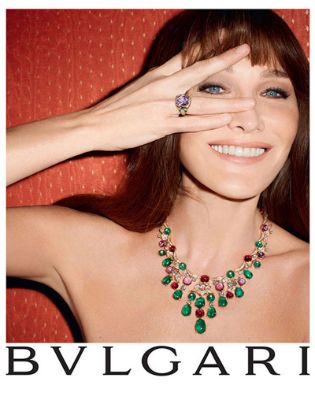 |
Vogue, under Wintour' stewardship, has gone into an odd amalgam of some beautiful things (mostly in the advertisements), to a "journalistic" type of magazine with interviews and stories on non-fashion subjects somewhat glamorized to fit the magazine. This is a magazine for the serious and fashionable woman.
Wintour, of course when things go too extreme can be ruthlessly Pro Beauty ( or pro decorum, at least). She banned the Hispanic pop star Jennifer Lopez from Vogue photo shoots (calling Lopez "low class") in after Lopez took off with some of the photo shoot clothing. It's o.k. if Lopez shows up as a bare-bodied prostitute, and appears as such in Vogue, but lo the repercussions if she steals items which would have been tossed out anyway.
Anna Wintour, who I think is at the mercy of her staff (everything seems to got through a committee in the life of these multi-million-dollar-generating magazines), and their "research" and "observations" would tell them that women are not into beauty anymore, and thus they should dig out ugliness, and of course politics. But, this is an utterly mistaken observation. Women want beauty as much as ever. It is Vogue, and the post-modern, modernist, anti-beauty elite that is dictating the terms.
But, there is no denying that the elitist Wintour does dress well.
Of course, for the elite, and especially the liberal elite (Wintour is a die-hard liberal and Obama supporter), all these experiments like building a world around ugliness, is for the rest of the world, as they, the elite, live in their gated lives (ideologically and geographically) to keep them immune for the havocs they wreck.
But watching The Devil Wears Prada a second time around, I found it surprisingly non-conventional (as in pursuing beauty seriously, and not in a post-modern, dark and and nihilistic way, but as something worthy of awe and wonder) where where Andy, the typical modern girl who has rejected of beauty, or more precisely picked up the in vogue idea of fashion as rejecting beauty, is beaten down by Runway's Miranda Priestly, and the assistant (played wonderfully by Stanley Tucci, whose played Julia Child's husband in Julie and Julia again with the formidable Meryl Streep) who tries to get this girl in the lumpy blue sweater to wear some couture.
The film is for young women (and older women like Streep who want to "mother" these young women). And young women, as I said above, still want to look pretty and nice. Older women almost always want to mother young women. And, to repeat myself, if this film tried to masculinize or uglify Andy, and demonize Miranda, it would not make it into the box office.
Perhaps "essence" will win over engineering. But so far, these social re-creators seem to have the upper hand.
Below are transcripts of a couple of scenes from The Devil Wears Prada:
Andy Comes for an interview to work in Runway, a fashion magazine run by Miranda Priestly
Miranda: Who are you?
Andy: Uh, my name is Andy Sachs. I recently graduated from Northwestern University.
Miranda: And what are you doing here?
Andy: Well I think I could do a good job as your assistant. And um……Yeah, I came to New York to be a journalist and sent letters out everywhere and finally got a call from Elias-Clarke. And met with Sherry up at Human Resources. Basically it’s this or Auto Universe.
Miranda : So you don’t read Runway ?
Andy : Uh, no.
Miranda : And before today, you had never heard of me.
Andy : No.
Miranda : And you have no style or sense of fashion.
Andy : I think that depends on what you’re-
Miranda : No, no. That wasn’t a question.
Andy: Um, I was editor in chief of the Daily Northwestern. I also, um, won a national competition for College journalists with my series on the Janitors union. Which exposed the exploitation of-
Miranda: That’s all
(Andy turns around to leave, then comes back)
Andy: Yeah. You know, okay. You’re right. I don’t fit in here. I am not skinny or glamorous and I don’t know that much about fashion but I’m smart. I learn fast and I will work very hard.
(Andy waists for a response, then turns around and leaves)
Andy: Thank you for your time.
---------------------------------------------------
Andy spills some food on her sweater while out to buy some take-out with her new collegue Nigel
Andy: Oh. Shoot.
Nigel: Oh, never mind. I'm sure you have plenty more polyblend where that came from.
Andy: Okay. You think my clothes are hideous. I get it. But, you know, I'm not going to be in fashion forever! So I don't see the point of changing everything about myself just because I have this job.
Nigel: Yes, that's true. That's really what this multibillion-dollar industry is all about anyway, isn't it? Inner beauty.
---------------------------------------------------
Andy gets taught a lesson (or two) by Miranda
Miranda: Where are the belts for this dress? Why is no one ready?
Assistant: Here. It's a tough call.
Miranda: They're so different. -[Miranda] Hmm.
Andy[Snorts, Chuckles]
Miranda: Something funny?
Andy: No. No, no. Nothing's...You know, it's just that both those belts look exactly the same to me. You know, I'm still learning about this stuff and, uh¡...
Miranda: 'This stuff'? Oh. Okay. I see. You think this has nothing to do with you. You go to your closet and you select... I don't know... that lumpy blue sweater, for instance because you're trying to tell the world that you take yourself too seriously to care about what you put on your back. But what you don't know is that that sweater is not just blue, it's not turquoise. It's not lapis. It's actually cerulean. And you're also blithely unaware of the fact that in 2002, Oscar de la Renta did a collection of cerulean gowns? And then I think it was Yves Saint Laurent... wasn't it who showed cerulean military jackets? I think we need a jacket here.
Nigel: Mmm.
Miranda: And then cerulean quickly showed up in the collections of eight different designers. And then it, uh, filtered down through the department stores and then trickled on down into some tragic Casual Corner where you, no doubt, fished it out of some clearance bin. However, that blue represents millions of dollars and countless jobs and it's sort of comical how you think that you've made a choice that exempts you from the fashion industry when, in fact, you're wearing the sweater that was selected for you by the people in this room from a pile of stuff.
-------------------------------------------------------------------------------------------------------------------------------------------------------------
Posted By: Kidist P. Asrat
-------------------------------------------------------------------------------------------------------------------------------------------------------------
